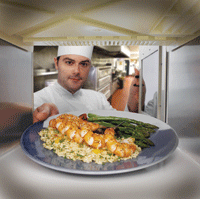 The microwave finds its place in foodservice
The microwave finds its place in foodservice
There’s no mistaking it; microwaves have been given a bad name. The mini cookers have been used in commercial kitchens for almost 60 years, but many chefs don’t recognize their relevance in today’s kitchens where cooking food fresh, from scratch, is the order of the day.
In actuality, many cooks lack the training and knowledge needed to appreciate a microwave’s value. But, once the microwave is accepted as a distinct piece of equipment, and used like other kitchen tools, it can earn its place on the line.
Perhaps, the microwave has been relegated to the back-burner due to a misconception — by calling these units ovens, manufacturers have done themselves and operators a disservice. To be more accurate, the machine should be called a microwave cooker.
Conventional ovens cook food by conducting heat from the surface to the centre of the product, browning it as amino acids and sugars reach 195°F. Since microwaves penetrate food to a depth of 1.5 inches this surface browning does not occur, which is why some chefs may overcook food in the microwave, blaming the poor results on the equipment.
The Back Story
Microwaves arrived on the scene following radar research during the Second World War; the first units for commercial food operations were developed by General Electric in 1945.
Here’s how they work: the machines are comprised of high-frequency radio waves produced inside a cavity by a vacuum tube magnetron, which converts electricity into short-length radio waves. The resulting “micro waves” are either reflected off metal surfaces, pass through other materials or are absorbed by moisture molecules (water, fat and sugars), which causes a vibration. The reason microwaves cause molecules to vibrate is the key to understanding what foods react well to microwave cooking.
Since water molecules are positively and negatively charged, the constantly changing magnetic field created by the magnetron causes the molecules to vibrate about 2.5-billion times per second, which creates intense heat from the friction; this heat spreads very quickly from the point of penetration throughout the food. Interestingly, the molecules vibrate for some time after the product has been removed from the unit, leading some cooks to put a dish back in the microwave, eventually overcooking it.
Weighing the Odds
The majority of homes now have microwaves, but such machines aren’t often suitable for commercial applications. It may be tempting to purchase a $200 consumer unit, but the results can be disappointing.
The power level of most consumer units range from 400 to 700 watts, whereas most commercial units are between 600 and 1,800 watts; as a result, the difference in speed and quality can be significant. Domestic-quality microwave ovens are not designed for the rigors of a foodservice operation, and operators using domestic quality microwaves — or any other low-grade appliances — run the risk of losing insurance should one of these units cause a fire. Expect to pay from $600 for an 800-watt unit with few features to $2,000 for a 1,700-watt unit with myriad features.
All commercial microwaves operate similarly, however there can be significant differences from one manufacturer to another in terms of wattage, cavity capacity, program controls and sturdiness of construction. Larger units usually have higher wattage and greater capacity. If they have two magnetrons the heat will be distributed more evenly throughout the cavity increasing load capacity and speed.
Finding the Right Fit
In most foodservice operations microwaves are used for primary cooking of small batches of food and for re-heating individual portions of cooked food. Once the functions and capacities needed have been determined, it’s simple to find the unit that meets those needs.
“It may be tempting to purchase a $200 concumer unit, but the results can be dissapointing.”
The combination convection/microwave oven is a current favourite in foodservice. Many operators favour this type of unit because it browns food like it would in a traditional oven, while offering the speed of a microwave. It’s an expensive machine, and the capacity is limited, but as the technology matures and the prices drop, it will undoubtedly replace traditional microwaves in most foodservice applications.
As operators continue to strive to speed up processes, some manufacturers are incorporating microwave technology into other types of equipment. One manufacturer is now adding microwaves to their combi-oven and to a panini press, speeding up an already quick process.
Get With the Program
One of the most common problems with early microwave models was an inability to control power levels. For example, a conventional oven set at 500°F would not achieve the desired results for every meal, and neither would a microwave set on high. But, controlling power levels, by subjecting the food to short bursts of energy at timed intervals, will yield much better results for almost all products.
These days, most models can be programmed for a variety of functions that control power level and time, depending on the type and quantity of product being cooked or re-heated. When creating these settings, consider food density, composition (fat, sugar and moisture content), portion size, quantity, bones in meat and cavity capacity. Work closely with manufacturers’ representatives to develop cooking procedures and standardize time and power levels for menu items.
Harnessing the Power
Sure, there are drawbacks, but microwaves can be helpful. Delicate vegetables can be steamed in less than three minutes and corn on the cob can be cooked in one minute.
And, microwaves can be used with other traditional cooking methods. For example, soup can be cooked, chilled, portioned and then re-heated directly in the serving bowl, as opposed to keeping it in a steam table where it will continue to cook and reduce during service; a half-roast chicken can be given a 30-second “push” in the microwave before traditional re-heating, reducing the time required to finish the dish; a thick steak cooked to medium on the grill can be finished to well done quickly and with better results in a microwave than on the grill; desserts and other foods that should be served warm or at room temperature can be kept refrigerated and then have the “fridge chill” removed in seconds; and, in a pinch, frozen foods can be defrosted on low or preset defrost cycles. And, since cooking time is reduced, the nutritional value, colour and flavour of certain foods is retained.
In addition to being quick and convenient, microwaves are also energy efficient. While the constant use of counter-top steamers or convection ovens can drain energy sources, a microwave only uses energy when the unit is in use, and no heat is lost to the surrounding area. And, since microwaves do not require venting or fire protection, they are an ideal way to increase cooking capacity at a relatively low cost. Perhaps the microwave isn’t so bad after all.
Vendor Information
Check out the cheatsheet below for the names and coordinates of microwave vendors:
For a complete equipment supplier’s list, check our Buyer’s Guide.
More in Feature Articles
A Rosy Outlook: Profiling Chef Rose of the Drake Hotel
Fishing For Dollars: How to Reel In Today’s Cautious Customer
The Pressure Cooker: Government Puts Pressure on Foodservice Operators
Sea Change: Tracing Seafood’s Sustainability Story





















